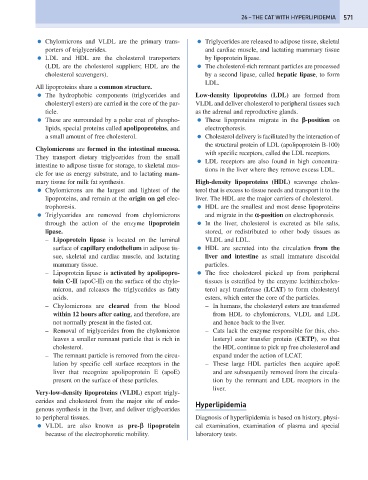Page 579 - Problem-Based Feline Medicine
P. 579
26 – THE CAT WITH HYPERLIPIDEMIA 571
● Chylomicrons and VLDL are the primary trans- ● Triglycerides are released to adipose tissue, skeletal
porters of triglycerides. and cardiac muscle, and lactating mammary tissue
● LDL and HDL are the cholesterol transporters by lipoprotein lipase.
(LDL are the cholesterol suppliers; HDL are the ● The cholesterol-rich remnant particles are processed
cholesterol scavengers). by a second lipase, called hepatic lipase, to form
LDL.
All lipoproteins share a common structure.
● The hydrophobic components (triglycerides and Low-density lipoproteins (LDL) are formed from
cholesteryl esters) are carried in the core of the par- VLDL and deliver cholesterol to peripheral tissues such
ticle. as the adrenal and reproductive glands.
● These are surrounded by a polar coat of phospho- ● These lipoproteins migrate in the β-position on
lipids, special proteins called apolipoproteins, and electrophoresis.
a small amount of free cholesterol. ● Cholesterol delivery is facilitated by the interaction of
the structural protein of LDL (apolipoprotein B-100)
Chylomicrons are formed in the intestinal mucosa.
with specific receptors, called the LDL receptors.
They transport dietary triglycerides from the small
● LDL receptors are also found in high concentra-
intestine to adipose tissue for storage, to skeletal mus-
tions in the liver where they remove excess LDL.
cle for use as energy substrate, and to lactating mam-
mary tissue for milk fat synthesis. High-density lipoproteins (HDL) scavenge choles-
● Chylomicrons are the largest and lightest of the terol that is excess to tissue needs and transport it to the
lipoproteins, and remain at the origin on gel elec- liver. The HDL are the major carriers of cholesterol.
trophoresis. ● HDL are the smallest and most dense lipoproteins
● Triglycerides are removed from chylomicrons and migrate in the α-position on electrophoresis.
through the action of the enzyme lipoprotein ● In the liver, cholesterol is excreted as bile salts,
lipase. stored, or redistributed to other body tissues as
– Lipoprotein lipase is located on the luminal VLDL and LDL.
surface of capillary endothelium in adipose tis- ● HDL are secreted into the circulation from the
sue, skeletal and cardiac muscle, and lactating liver and intestine as small immature discoidal
mammary tissue. particles.
– Lipoprotein lipase is activated by apolipopro- ● The free cholesterol picked up from peripheral
tein C-II (apoC-II) on the surface of the chylo- tissues is esterified by the enzyme lecithin:choles-
micron, and releases the triglycerides as fatty terol acyl transferase (LCAT) to form cholesteryl
acids. esters, which enter the core of the particles.
– Chylomicrons are cleared from the blood – In humans, the cholesteryl esters are transferred
within 12 hours after eating, and therefore, are from HDL to chylomicrons, VLDL and LDL
not normally present in the fasted cat. and hence back to the liver.
– Removal of triglycerides from the chylomicron – Cats lack the enzyme responsible for this, cho-
leaves a smaller remnant particle that is rich in lesteryl ester transfer protein (CETP), so that
cholesterol. the HDL continue to pick up free cholesterol and
– The remnant particle is removed from the circu- expand under the action of LCAT.
lation by specific cell surface receptors in the – These large HDL particles then acquire apoE
liver that recognize apolipoprotein E (apoE) and are subsequently removed from the circula-
present on the surface of these particles. tion by the remnant and LDL receptors in the
liver.
Very-low-density lipoproteins (VLDL) export trigly-
cerides and cholesterol from the major site of endo-
Hyperlipidemia
genous synthesis in the liver, and deliver triglycerides
to peripheral tissues. Diagnosis of hyperlipidemia is based on history, physi-
● VLDL are also known as pre-β lipoprotein cal examination, examination of plasma and special
because of the electrophoretic mobility. laboratory tests.

